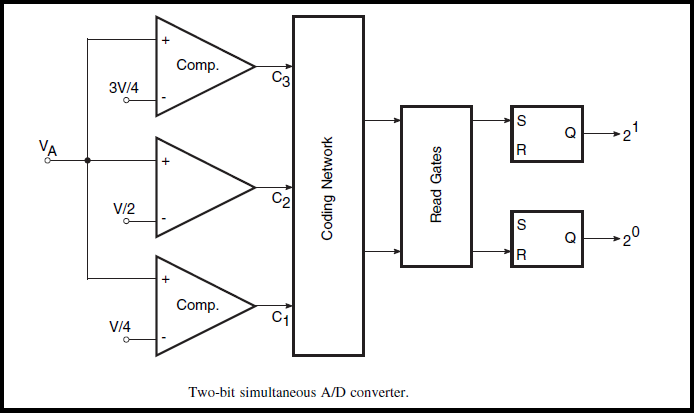Now we shall see the simultaneous or flash ad converter. In my earlier post we discuss on how analog to digital converter works? As the name suggest, simultaneous method of A/D conversion is based on using a number of comparators. And it has process of conversion analog to digital, running simultaneously. The number of comparators needed for making a n-bit simultaneous or flash ad converter is 2n−1.
Working Process
Let suppose we take an example of two bit simultaneous or flash ad converter. One such system capable of converting an analogue input signal into a two-bit digital output shown below.


Firstly, the analogue signal to be digitized serves as one of the inputs to each of the comparators. Secondly, the second input for each of the comparators is a reference input, different for each comparator. Finally, the reference voltages to be used for comparators are in general V/2n, 2V/2n, 3V/2n, 4V/2n and so on. Here, V is the maximum amplitude of the analogue signal that the A/D converter can digitize, and n is the number of bits in the digitized output.
In the present case of a two-bit A/D converter, the reference voltages for the three comparators will be V/4, V/2 and 3V/4. If we wanted a three-bit output, the reference voltages would have been V/8, V/4, 3V/8, V/2, 5V/8, 3V/4 and 7V/8. As we see from above diagram that the output status of various comparators depends upon the input analogue signal VA. For instance, when the input VA lies between V/4 and V/2, the C1 output is HIGH whereas the C2 and C3 outputs are both LOW. Now question is what will be output or results? Those possible results shown in bellow table.
Output
Now another question arrived in our mind that how these output comes? See the above diagram of flash ad converter carefully that outputs of the three comparator can then be fed to a coding network to provide two bits which are the digital equivalent of the input analogue voltage. The bits at the output of the coding network can then be entered into a flip-flop register for storage.
Conclusion
The construction of a simultaneous or flash AD converter is quite straightforward and relatively easy to understand. However, as the number of bits in the desired digital signal increases, the number of comparators required to perform A/D conversion increases very rapidly. And it may not be feasible to use this approach once the number of bits exceeds six or so. The greatest advantage of this technique lies in its capability to execute extremely fast analogue-to-digital conversion.
Let’s check how you learn “Simultaneous or Flash AD Converter” with a simple quiz.
0 of 5 questions completed Questions: Analogue to Digital Converter You have already completed the quiz before. Hence you can not start it again. Quiz is loading... You must sign in or sign up to start the quiz. You have to finish following quiz, to start this quiz: 0 of 5 questions answered correctly Time has elapsed You have reached 0 of 0 points, (0) The time taken by the ADC from the active edge of SOC(start of conversion) pulse till the The popular technique that is used in the integration of ADC chips is Which is the ADC among the following? The number of inputs that can be connected at a time to an ADC that is integrated with The conversion delay in successive approximation of an ADC 0808/0809 isADC
Quiz-summary
Information
Results
Average score Your score Categories
1. Question
active edge of EOC(end of conversion) signal is called 2. Question
3. Question
4. Question
successive approximation is 5. Question





